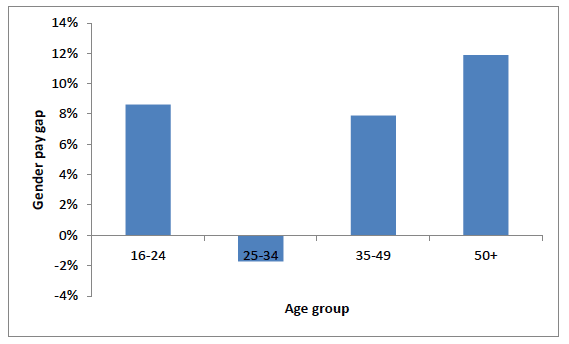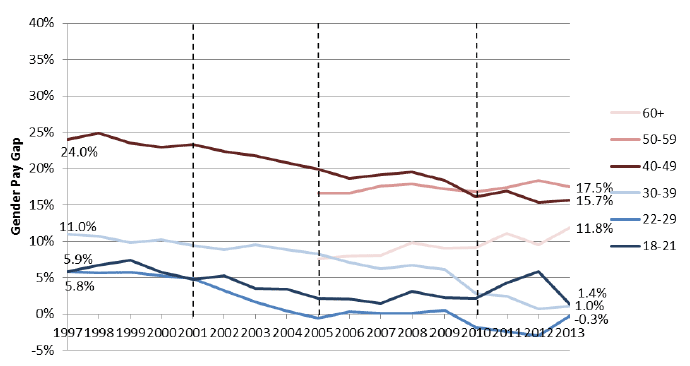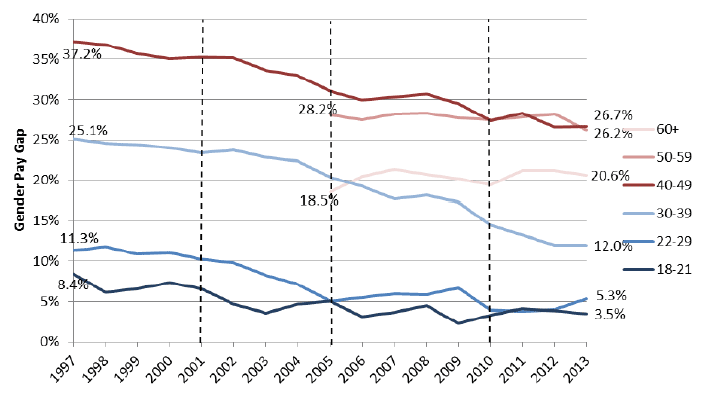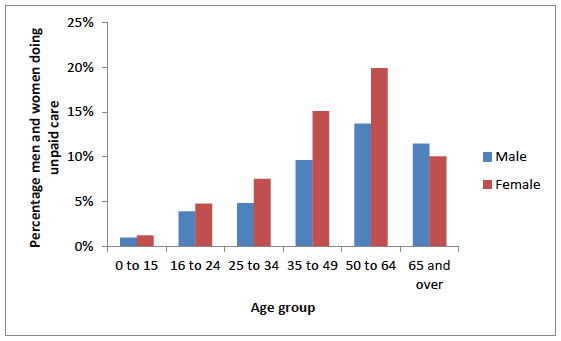New perspectives on the gender pay gap: trends and drivers
This report explains the different measures of the gender pay gap and considers how it has been changing over time. It also considers underlying drivers and describes Scottish Government policy intended to help encourage the decline of the pay gap.
2. The Pay Gap by Age Group
The pay gap differs greatly for different age groups. UK [5] and Scottish analysis of the Annual Survey of Hours and Earnings ( ASHE) shows that the full-time pay gap is generally lower for younger age groups than for older groups.
The chart below shows that in Scotland the pay gap was almost zero or negative for the 25-34 age group in 2015, but there was a much higher pay gap for those aged 16-24. This is broadly consistent with the previous year's data.
Figure 2: Gender pay gap - median hourly earnings excluding overtime - full-time by age 2015, Scotland

Source: Annual Survey of Hours and Earnings, ONS
Note: covers employees age 16+ on the PAYE system on adult rates and whose pay was not affected by absence.
Longer term data ( UK only), presented in Figure 3 illustrates that the pay gap has been reducing for age groups below 50.
The full-time pay gap for age groups under 40 (those born after 1973) was close to zero in 2013. But age groups 50 or over have seen little overall change in the pay gap, even as people from younger cohorts move into them. So, the full-time gender pay gap was almost entirely attributable to those aged 40 or over (those born earlier than 1973).
This suggests that policymakers need to consider how policies to reduce the pay gap are likely to affect different age groups.
Figure 3: Gender pay gap for FULL-TIME employees by age group (median hourly earnings excluding overtime), UK 1997-2013

Source: UK Department for Culture Media and Sport (2014) Secondary Analysis of the Gender Pay Gap - changes in the gender pay gap over time.
The decrease in the under 40 pay gap over time is partly due to a 'cohort effect' within age groups below 50 - meaning that the pay gap of each age groups decreases over time as younger people age and move into them. The cohort effect is likely to relate to differences in education levels and qualifications between generations.
Scottish Government analysis suggests that an ongoing cohort effect is likely to continue to narrow the full-time pay gap further over time as employees born in the 1950s leave the labour market and are replaced by those born in the 1990s who have different education levels along with different career and life expectations.
But, it is not clear from the data why the pay gap has remained high, or increased for the 50-59 and 60+ age groups. Factors could include women traditionally retiring earlier than men, and therefore beginning the 'winding down' (with pay reductions) phase earlier than men, many of whom are still achieving maximum earnings. This may change as the state pension age for women is raised to the same level as men - 65 by December 2018.
Figure 4 shows the UK pay gap for all employees, including part-time. The trends are similar to the full-time pay gap, but the gaps for all age groups are higher than for full-time employees. This is because part-time work is lower paid and more frequently done by women.
Figure 4 - Gender pay gap for ALL employees by age group (gross hourly earnings excluding overtime), UK 1997-2013

Source: UK Department for Culture Media and Sport (2014) Secondary Analysis of the Gender Pay Gap - changes in the gender pay gap over time.
Women are more likely to work part-time largely due to the fact that they undertake more unpaid care than men. Figures are not available on hours of informal childcare provided by gender, but Figure 5 shows that women are a lot more likely than men to be doing unpaid care of disabled or elderly family, friends or neighbours - across all age groups but particularly in age groups 35-49 and 50-64.
In general, informal unpaid care includes looking after children, grandchildren, partners, parents or relatives, all of which increase the likelihood of work disruption, and encourages reduction of hours and less demanding work in order to balance work/care commitments. As the population ages and more elderly parents require longer care, this issue will continue to be an important influence on older age groups ( e.g. 50 and over) who are most likely to have elderly parents in need of support.
Figure 5: Provision of unpaid care by sex by age, Scotland, 2011

Source: Scotland's Census 2011. Table DC3103SC - Provision of unpaid care by sex by age
KEY MESSAGE: across all age groups, it is unlikely that the cohort effect alone will lead to an elimination of the gender pay gap. A residual pay gap can be expected due to other drivers including barriers to economic progress that women face, for example: structural differences in women and men's working patterns, demographic pressures and gendered attitudes towards care, labour market issues (such as occupational segregation) and factors like direct and indirect discrimination.
Contact
There is a problem
Thanks for your feedback